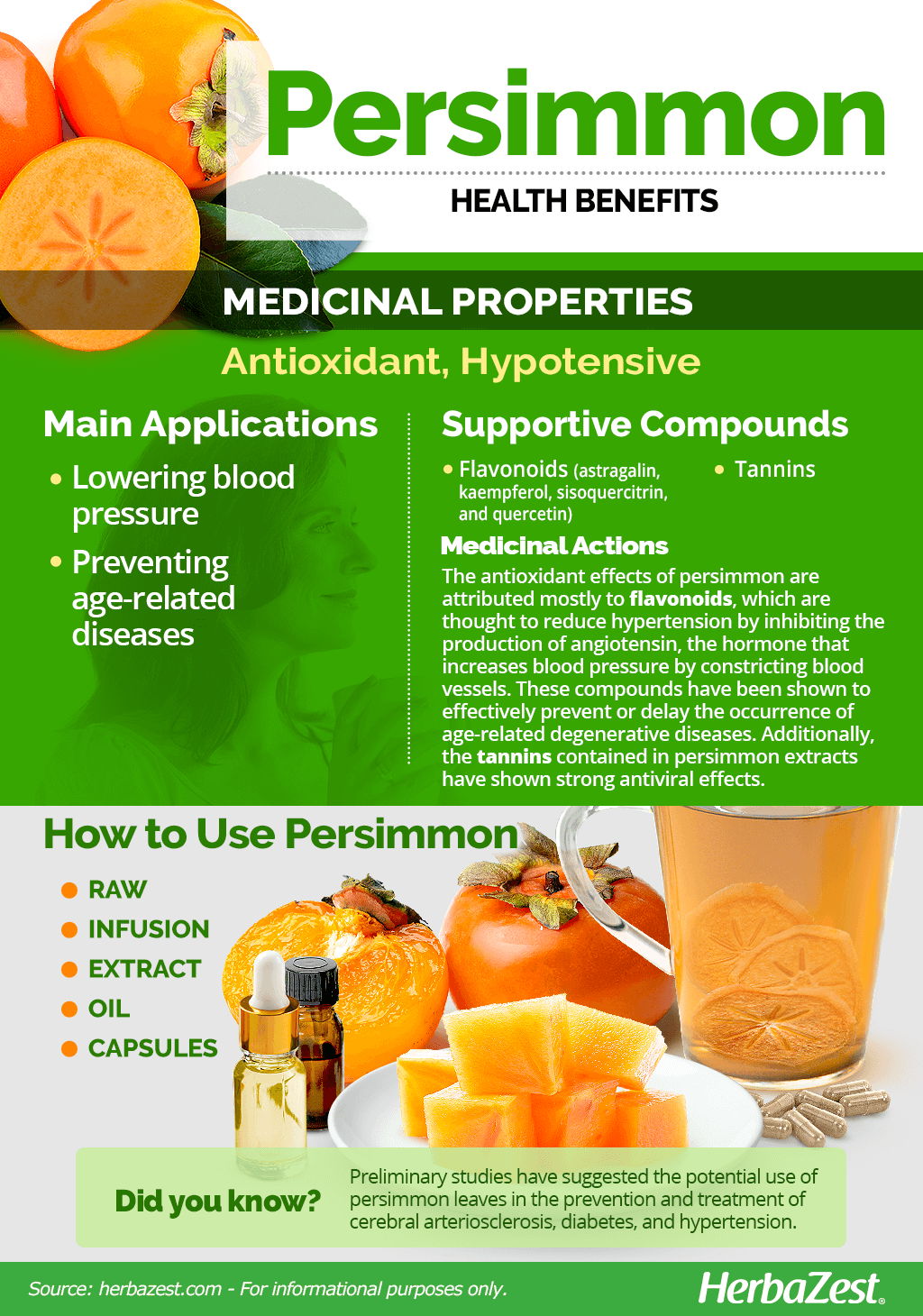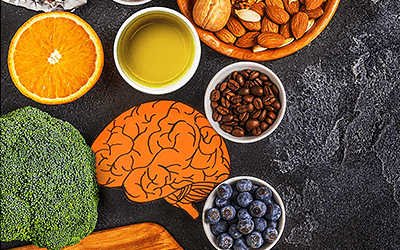Persimmon fruits are a delicacy in many Asian countries, to where they are native, and persimmon trees are a common sight along roads, fields, and even family backyards all over Japan. In addition to its taste and ornamental value, persimmon is also treasured as a medicinal plant in Traditional Chinese Medicine (TCM), and it is considered to have several healing properties, some of them corroborated by modern science.
Persimmon Medicinal Properties
Health Benefits of Persimmon
Although not all of persimmon's traditional uses have been supported by science, studies have found that the fruit offers several important properties, including:
Lowering blood pressure. Persimmon contains compounds that can regulate blood vessel tension and blood pressure.
Delaying age-related diseases. Cellular oxidation due to the effect of free radicals, which happens over time and can cause arthritis, atherosclerosis, cataracts, and Alzheimer's, among other degenerative illnesses, may be reduced by persimmon.
How It Works
Major constituents of persimmon are astralagin, kaempferol-3-O-glucoside, sisoquercitrin, and quercetin-3-O-glucoside, all of which are thought to be responsible of reducing hypertension by inhibiting the production of angiotensin, the hormone that increases blood pressure by constricting blood vessels.1
The antioxidant effects of persimmon are mostly attributed to flavonoids, which are phenolic compounds that are ubiquitous in the plant kingdom and particularly abundant in persimmon. These compounds have been shown to effectively prevent or delay the occurrence of age-related degenerative diseases.2
Additionally, the tannins contained in persimmon extracts have shown strong antiviral effects against a broad range of viruses, which has led to the consideration of the fruit for potential use in supplements as a safe and highly-effective agent against harmful pathogens.3
Preliminary studies suggest the potential use of persimmon leaves in the prevention and treatment of cerebral arteriosclerosis, diabetes, and hypertension.
Other herbs with hypotensive effects are potato and saffron, while blueberries and turmeric also have powerful antioxidant compounds, which help prevent age-related diseases.
Persimmon Side Effects
Persimmon fruits are considered safe in culinary amounts, but due to lack of research, their side effects remain unknown when administered in medicinal doses. In sensitive individuals, the fruit may cause allergic reactions, including rash, nausea, and difficulty breathing.
Persimmon Cautions
Due to its hypotensive actions, persimmon is likely to increase the effects of blood pressure medications; as such, it may be unsafe for those who already have hypotension.
Persimmon consumption should also be avoided up to two weeks before surgery in order to prevent lower blood pressure during the procedure.
While persimmon is included among the safest fruits to consume during pregnancy and lactation, women going through these stages are not recommended to use it in medicinal forms.
- Medicinal action Antioxidant, Hypotensive
- Key constituents Astralagin, kaempferol, sisoquercitrin, quercetin
- Ways to use Capsules, Hot infusions/tisanes, Liquid extracts, Essential oil
- Medicinal rating (2) Minorly useful plant
- Safety ranking Safety undetermined
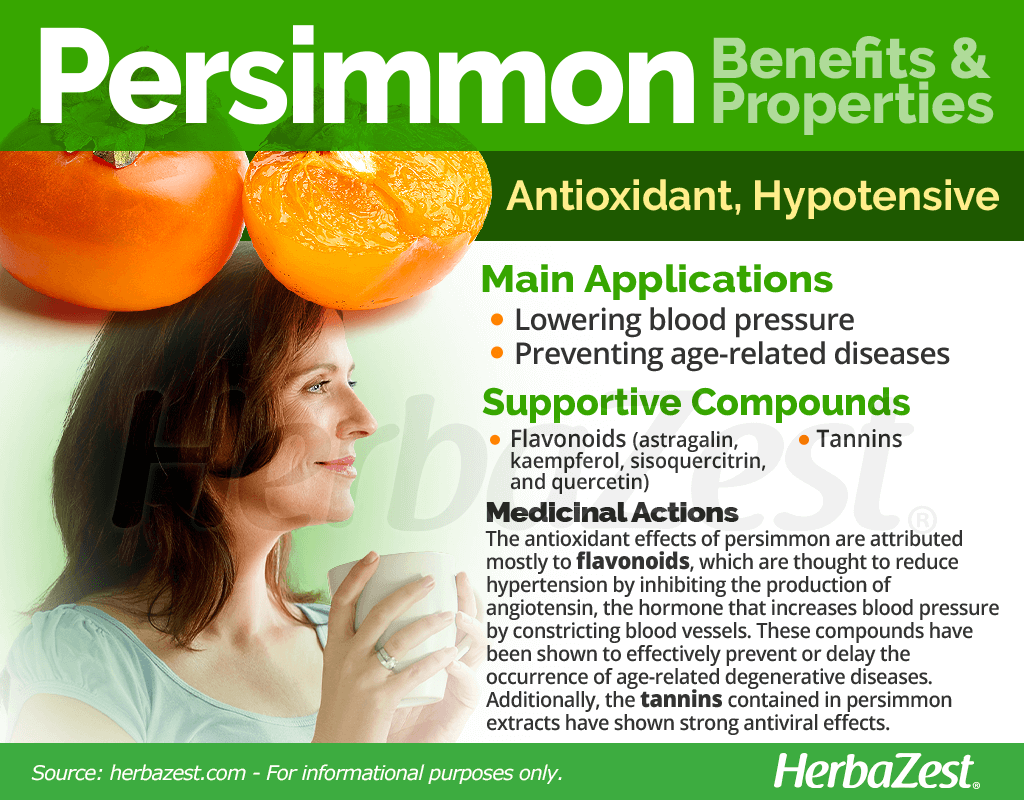
Persimmon Nutrition
In spite of its relatively high sugar content, the persimmon fruit is a good source of dietary fiber, which increases satiety and slows down glucose absorption. It also provides fair amounts of several essential nutrients.
The most relevant minerals in persimmon are copper and manganese, both of which play an important role in energy production and metabolic functions. Copper is crucial for the transport of red blood cells, and it is also involved in the formation of red blood vessels (angiogenesis) as well as in brain development. Manganese, on the other hand, is key for cholesterol regulation, bone formation, and immune response. Persimmon also provides adequate amounts of potassium, necessary for kidney and heart health, along with proper muscle contraction and nervous function.
For being such a delicious fruit, persimmon is not exactly a powerhouse of vitamins; however, it offers good amounts of pro-vitamin A (from carotenes) and vitamin C (ascorbic acid), both crucial for skin regeneration and strong immunity, along with vitamin B6 (pyridoxine), essential for brain development, serotonin and norepinephrine production (both hormones that influence mood), and melatonin levels (which help regulate sleep patterns). B6 is also essential for vitamin B12 absorption as well as for the production of hemoglobin and immune cells.
100 grams of fresh persimmon fruit provide 70 calories, including 25%DV of sugar, 14%DV of dietary fiber, 6%DV of carbohydrates, and 1%DV of plant-based protein.
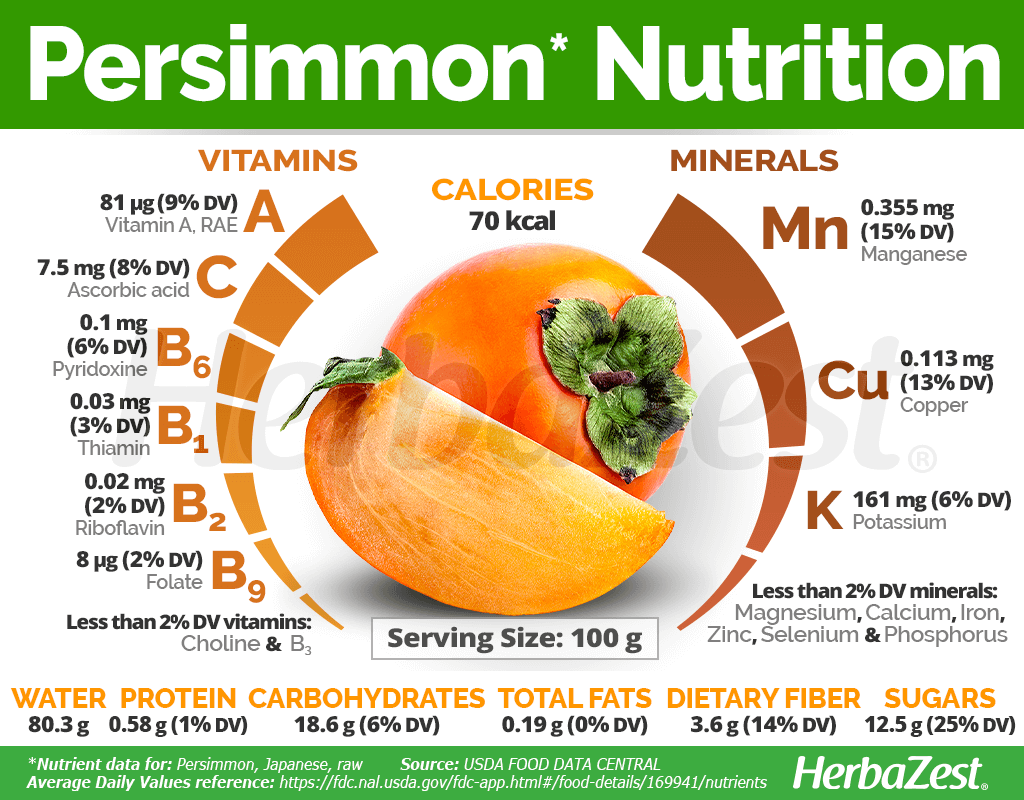
How to Consume Persimmon
Persimmon fruit is popularly consumed fresh and used in a variety of culinary preparations because of its sweet taste, but it also has medicinal applications; both the fruit and leaves of persimmon can be consumed in supplements and herbal remedies.
Natural Forms
Raw. Persimmons are consumed once they have ripened, when they become sweet. They are commonly eaten raw, but can also be blended into smoothies, added to salads, preserves, or custards, or cooked savory dishes.
Infusion. Taking a warm herbal tea made from persimmon leaves is especially useful for reducing blood pressure.
Herbal Remedies & Supplements
Extract. Persimmon extract is a more concentrated preparation, used in medicinal doses to lower blood pressure and help reduce cellular oxidation.
Oil. Persimmon oil should only be applied externally. It is thought that its antioxidant properties may benefit the skin and delay signs of aging.
Capsules. Taken as a supplement in fixed daily doses, capsules provide the hypotensive and antioxidant benefits of persimmon, but without the taste or texture that some people may dislike.
- Edible parts Fruit
- Taste Sweet
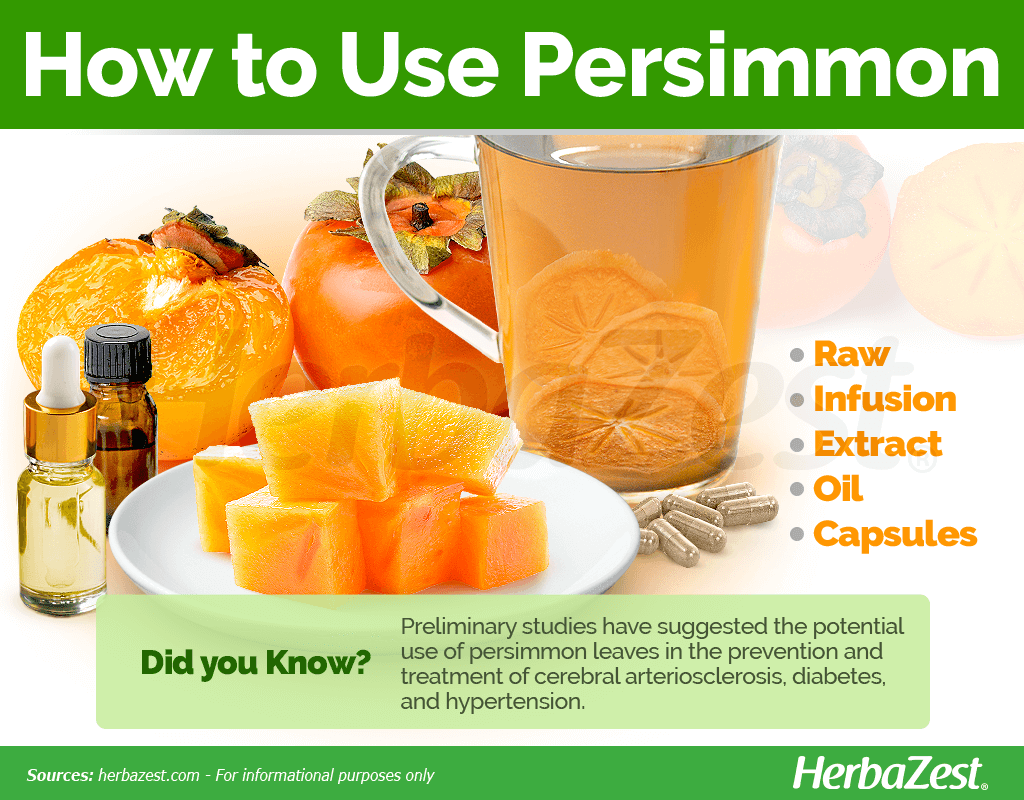
Growing
Although persimmon is native to Asia, it is now naturalized all over the world and can be grown in many conditions. However, because it is very difficult to propagate it by seed, the best way to grow a persimmon plant is to buy a seedling or young tree from a nursery or garden center.
Growing Guidelines
A persimmon tree can occasionally be grown from a seed, but it is more likely to be propagated by cuttings or grafting.
Persimmon trees can thrive in different types of soil, as long as they are moderately fertile and well-drained, with deep subsoil. For instance, the plant does well in sandy loam with a clay subsoil.
While it is a hardy species and tolerates different terrains, the best soil for growing persimmon trees is neutral, with a pH level of 6.5 - 7.5.
Persimmon can be grown in a wide range of climates, from subtropical to mild temperate. However, the tree should not be exposed to temperatures below 20°F (-7°C).
While usually grown in full sun, persimmons may benefit from some shade in especially sunny locations.
The trees should be spaced at least 20 feet (6 m) apart so they have enough room to grow.
Young persimmon trees need frequent moisture, and even older trees should be provided with adequate irrigation.
Persimmon trees may benefit from the application of a mix of nitrogen, phosphorus, and potassium; however, too much nitrogen will reduce the quality of the harvest.
Persimmon trees can be pruned when young to develop a good shape, and then pruned periodically as needed.
Most cultivars will bear fruit between three to six years after planting.
Persimmon fruits are harvested in the fall and early winter.
The main pests that bother persimmon are mealybugs, which will cause damage in young trees but not in mature ones.
Fungal diseases such as root rot or leaf spot may also cause problems for the plant.
More detailed information about growing persimmon can be found in the herb garden section.
- Life cycle Perennial
- Harvested parts Fruit
- Light requirements Full sun, Partial shade
- Soil Light (sandy), Medium (loam), Loamy sand, Heavy clay, Well-drained
- Soil pH 6.6 – 7.3 (Neutral)
- Growing habitat Temperate climates, Subtropical regions, Warm climates
- Planting time Early spring
- Plant spacing average 7 m (22.97 ft)
- Propagation techniques Cuttings, Grafting
- Potential insect pests Mealybugs
- Potential diseases Leaf spot, Root rot
Additional Information
Plant Biology
The persimmon tree can grow 15 - 60 feet (4.5 - 18 m) tall and spread 15 - 20 feet (4.5 - 6.0 m). The leaves are oval-shaped and 3 - 10 inches (7.5 - 25 cm) long. Fruits differ in shape, depending on the variety, and may be anything from round to conical to nearly square. They have a smooth, shiny skin that can range from yellow to red to orange, or sometimes dark brown.
Classification
Persimmon, botanically named Diospyros kaki, is a member of the Ebenaceae family. Many of the plants in this group grow in tropical or subtropical regions throughout the world, and they are often popular for both their fruit and their ornamental qualities.
Varieties and Subspecies of Persimmon
There is one recognized variety of persimmon, D. kaki var. sylvestris. It is also referred to as yama-gaki, or mountain persimmon. There are also several cultivars, such as 'Hachiya' from Japan, that are astringent and virtually inedible if not left to soften after being picked. On the other hand, the 'Fuyu' cultivar does not contain tannins and can be eaten straight off the tree like an apple.
D. kaki is closely related to several types of persimmon that grow naturally in the United States, such as the American persimmon, D. virginiana, and the Texas persimmon, D. texana. These two trees also grow fruit, but they are more commonly ornamental and their fruits are not usually eaten.
Historical Information
The persimmon tree is native to East Asia, which includes Japan, as well as parts of China and the Himalayas. Persimmons are considered a delicacy in many parts of Asia, and the introduction of the fruit into Europe began in the 14th century, when Marco Polo traveled to China. Commodore Perry brought seeds to the United States in 1856, and the tree has been grown in several southern states as well as few more northern states since then.
Economic Data
Persimmons are not one of the most important crops worldwide, but they are still popular enough to make up a significant trade. China is the number one producer of persimmons, with 3.73 million tons produced in 2014. Other top producers that year were South Korea, Japan, Spain, and Brazil.
Popular Beliefs
In Japan, persimmon is associated with good luck and longevity. Because of this, it is a popular fruit to eat and use in baking around the New Year.
Other Uses
Timber. The persimmon tree is popularly grown for its strong wood, which can be used in woodworking to make objects such as golf clubs.
Gardening. Persimmon is also commonly grown as an ornamental plant.
Persimmon is a unique fruit that has conquered the world due to its delicious flavor and many health benefits. It is a valuable medicinal plant worth consuming as part of a healthy diet or as a remedy for a number of common illnesses.
- Other uses Furniture/carpentry
Sources
- Edible Medicinal And Non-Medicinal Plants, pp. 428 - 441
- Medicinal Plants of the Asia-Pacific: Drugs for the Future, pp. 230 - 231
- Purdue Horticulture and Landscape Agriculture, Japanese Persimmon
- Texas A&M Agrilife Extension, Persimmons
- Washington State University, Persimmons: An over-view of cultivars, production, harvesting, and marketing
- Germplasm Resources Information, Taxon: Diospyros kaki Thunb.
- Journal of Ethnopharmacology, Neuroprotective effects of a standardized flavonoid extract from Diospyros kaki leaves, 2009 | Persimmon (Diospyros kaki L.) leaves: a review on traditional uses, phytochemistry and pharmacological properties, 2015
Footnotes:
- Bioscience, Biotechnology, and Biochemistry. (2011)Antihypertensive and vasorelaxant effects of water-soluble proanthocyanidins from persimmon leaf tea in spontaneously hypertensive rats. Retrieved September 22, 2023, from: https://pubmed.ncbi.nlm.nih.gov/21821959/
- EXCLI Journal. (2015). Persimmon (Diospyros kaki) fruit: hidden phytochemicals and health claims. Retrieved September 22, 2023, from: https://www.ncbi.nlm.nih.gov/pmc/articles/PMC4817420/
- PLOS ONE. (2013). Inactivation of Pathogenic Viruses by Plant-Derived Tannins: Strong Effects of Extracts from Persimmon (Diospyros kaki) on a Broad Range of Viruses. Retrieved September 22, 2023, from: https://pubmed.ncbi.nlm.nih.gov/23372851/
